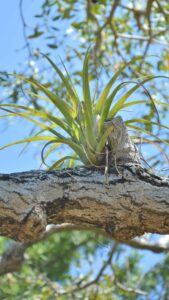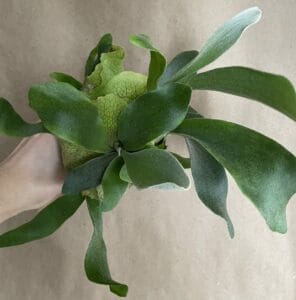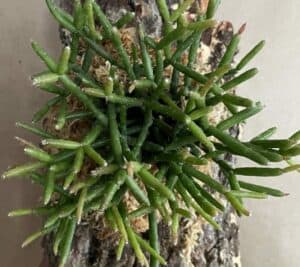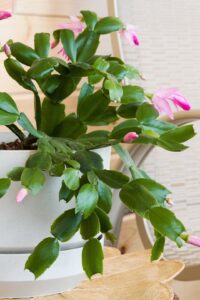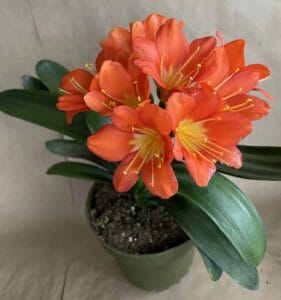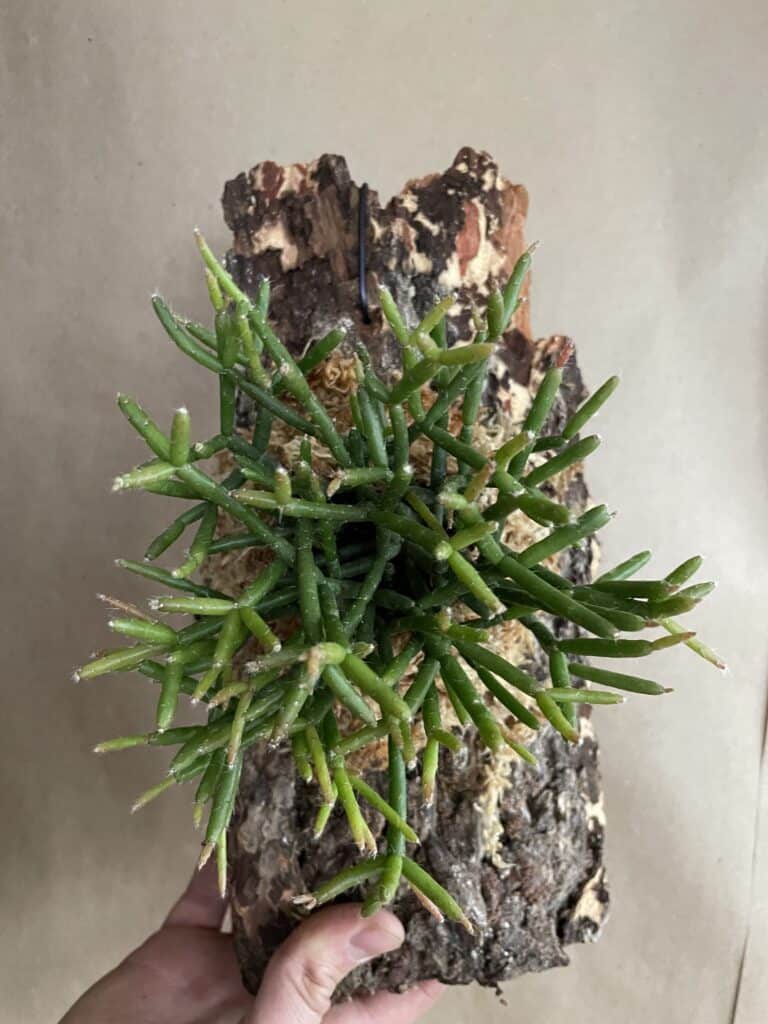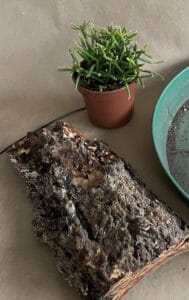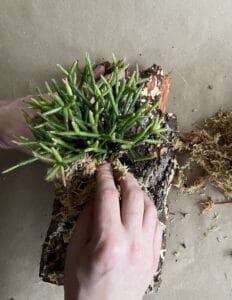Shop Mother’s Day Bouquets
Figaro's Blog

Looking to spice up your indoor garden? Consider introducing an epiphyte: a plant that thrives without the need for soil. Many of us are familiar with the popular air plant (Tillandsia spp.), but there are many more epiphytic house plants to choose from. In this post, we’ll explore the basics of their care, meet some of our favourite epiphytes, and look at the advantages of mounting epiphytic house plants.
What is an Epiphytic Plant?
Unlike their soil-rooted counterparts, epiphytic plants have evolved to thrive in the air, perching on trees or other plants without embedding their roots. These botanical oddities have developed unique adaptations, often featuring specialized structures like aerial roots to absorb moisture and nutrients from the air. Epiphytes are not parasites; they don’t take nutrients from their hosts but rather use them as convenient platforms. This allows them to flourish in diverse environments, from rainforests to—less commonly—arid deserts.
General Care Principles for Epiphytic Plants
Despite their natural propensity to establish themselves on trees and other soilless surfaces, epiphytes can be grown in containers as you would other houseplants or mounted to mimic their natural growth habit. Keep your epiphytic house plants happy and flourishing by supporting their needs.
Best Soil for Epiphytic House Plants
While soil may not be the main stage for these plants, it still plays a supporting role. If you’re growing an epiphytic house plant in a container, opt for a well-draining mix to keep things light and airy. You’ll keep your epiphytes happy in a blend that includes orchid bark, perlite, and sphagnum moss. We recommend either our Aroid Blend or Orchid Blend depending on how much light and warmth your space provides. Some growers opt to add additional perlite to ensure really good drainage.
Watering Epiphytes
Despite many epiphytes originating in tropical and humid rainforests, in their natural environment they repeat a wet-dry cycle frequently and don’t tend to sit in water. Problems arise when your soil isn’t drying out between waterings, causing rot. Alongside using a well-draining soil medium, make sure you aren’t overwatering—test for soil moisture before you pour. Not growing in soil? Tillandsia and mounted epiphytes can be soaked in room-temperature water for an hour.
Light Requirements for Epiphytic House Plants
Epiphytes grow in a variety of light conditions, from direct sunlight to heavy shade—learn more about your particular plant to determine how much light it needs. Bright, indirect light is a safe bet. Be mindful of direct sunlight, which can be a bit too much for some.
Examples of Common Epiphytic Plants
Let’s meet the stars of the show. We know and grow all of these epiphytes successfully:
Staghorn Fern (Platycerium bifurcatum)
A plant that looks like a work of art hanging on your wall: that’s the staghorn fern. Known for its unique fronds that resemble antlers, this epiphyte is one of the most popular choices for mounting. Keep the staghorn fern hydrated by soaking its shield fronds (the round, hard plate-like leaves that surround the base of the plant and protect the roots while taking up nutrients and water). A good rule of thumb is to water once a week during warmer and drier months. You can extend that to once every two weeks during cooler or more humid months. Provide bright, filtered light for best results.
Mistletoe Cactus (Rhipsalis baccifera)
With its thin foliage and trailing growth habit, the mistletoe cactus is a popular hanging plant. Although it is a true cactus, it has tropical rain forest origins so enjoys a humid environment and indirect light. Unlike most cacti, it can even do well in lower light locations. Prefers an evenly moist growing medium.
Hare’s Foot Fern (Davallia fejeensis)
With finely divided fronds attached to papery rhizomes that resemble tiny furry paws, the hare’s foot fern grows well in containers or hanging baskets. Provide this Fiji native with bright indirect light and water when the top inch of soil is dry.
Christmas Cactus (Schlumbergera x buckleyi)
Both Thanksgiving and Christmas cactus are tropical, epiphytic cacti, flowering year after year if cared for properly. Native to the shady, humid forests and higher altitudes of southeast Brazil, the plants prefer cool temperatures—especially in the development of flower buds. Bud development in these cacti is also influenced by day length; Christmas cactus sets buds when days shorten and the plant is in darkness for 12 or more hours each day. Once buds begin to form, keep the soil evenly moist and fertilize every two weeks. At other times of year, provide bright, indirect light and let the soil dry out between waterings. With a little care, you’ll be enjoying stunning blooms when the season arrives.
Clivia (Clivia miniata)
Elegant and robust, the clivia is a showstopper. Technically a semi-epiphyte, clivia is native to sub-tropical South Africa. In its native habitat it grows in the rich decomposing leaf mold found under trees, between rocks, or on fallen logs. In our homes it appreciates bright, indirect light and a well-draining soil medium. It prefers to stay on the cooler, drier side. Water sparingly (about once a month) until flower stalks appear, then move plants to a slightly warmer location and begin to water more frequently. Clivias typically bloom for several weeks in late winter or early spring.
Hoya (Hoya spp.)
Hoya, commonly known as the Wax Plant, is a fascinating genus of tropical, evergreen succulents native to Southeast Asia and Australia. Renowned for its waxy, star-shaped flowers and thick, leathery leaves, the Hoya is an epiphyte in its natural habitat, often found growing on trees. Hoyas require well-draining soil and moderate to bright indirect light. These plants are resilient and can tolerate periods of drought. Regular pruning helps maintain a compact and bushy appearance, and occasional fertilization during the growing season supports optimal health.
Orchid
Last but certainly not least, the orchid family is largely made up of epiphytes (approximately 70% of orchid types—including the popular Phalaenopsis, Cattleya, and Dendrobium genera—are epiphytes). Native to the tropics and subtropics, orchids in their natural habitat experience stable day lengths and temperature ranges. They tend to grow most happily about halfway up the tree in light shade, and are drawn to tree crevices where they can find an accumulation of humus or organic debris. To keep them healthy, be sure not to overwater, provide bright but diffuse light, feed them weekly, and repot into a specially designed orchid blend after blooming.
Mounting Epiphytes: A Smart Option
A creative way to display your epiphytic house plants is through mounting. Mounting is not only a visually appealing way to showcase your plants, but it also mimics their natural habitat, promoting better air circulation and moisture management.
Advantages of Mounting Epiphytic House Plants
1. Better air circulation: Mounted epiphytes enjoy improved air circulation, reducing the risk of diseases and promoting overall plant health.
2. Enhanced aesthetic appeal: Mounted plants are unique and eye-catching.
3. No overwatering: It’s hard to overwater a mounted epiphyte. Mist mounts daily (a pressurized sprayer makes this quick and easy) or give mounts an hour-long dunk in room-temperature water every few days.
Step-by-Step Guide to Mounting Epiphytic House Plants
Here’s some advice for mounting epiphytes at home:
1. Select a mounting base: Choose a piece of bark, wood, cork, or even a hardwood branch as the foundation for your mounted epiphyte. Hardwoods last longer than softwoods and cork, which have a tendency to decay more quickly.
2. Prepare the mount: Clean any soil or debris from your mount. If you want to hang it when finished, drill a hole through the back. Next, insert anodized aluminium wire and form a hook at the back of the mount. Secure fishing line or twine to the hook, or, if not planning to hang it, to the mount itself.
3. Position the plant: Gently remove your epiphytic plant from its pot and remove excess soil without disturbing the roots. Place the plant on the mounting base in the desired position.
4. Protect the plant’s root ball: Carefully pack moss around the roots, being careful not to wedge moss between the roots and the mount; you want the moss to be on top of the roots. We prefer New Zealand long fibre sphagnum moss for this task.
5. Secure the plant: Carefully wrap your fishing line around the base of the plant, securing it to the mount. Wrap several times, or until your plant is stable and well attached.
Place it in a shaded area initially, gradually moving it to its preferred light conditions.
Get creative with your mounted epiphytes: Suspend from the ceiling for a floating garden effect, arrange multiple mounted plants on a wall to create living art, or use smaller mounted epiphytes as centrepieces for your dining or coffee table. It’s a simple yet effective way to bring nature into your living space.
plants make everything better
Whether you're an experienced horticulturist, or looking for your first plant, our team at Figaro's Garden is excited to help you realize your plant and garden dreams. Contact us today or stop by the shop to see what's in-store.

